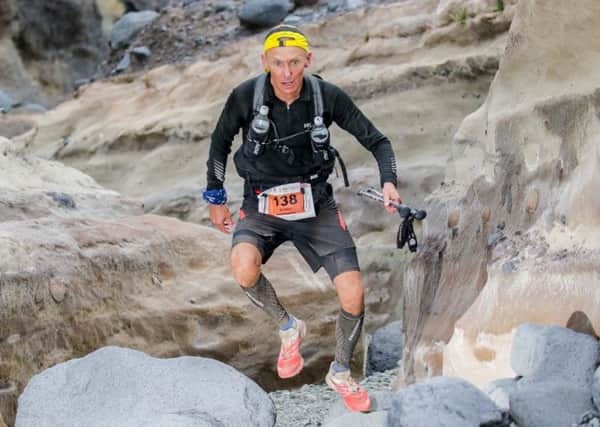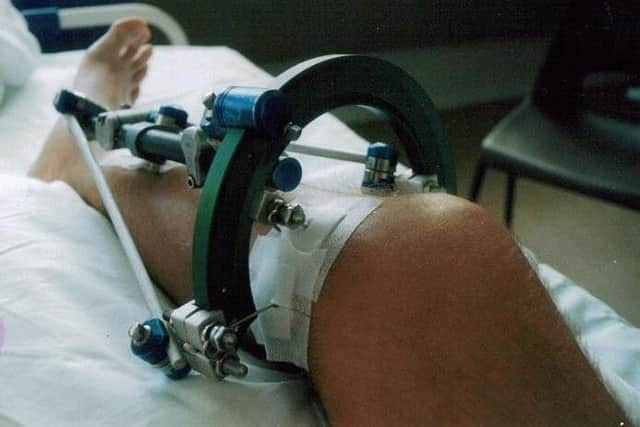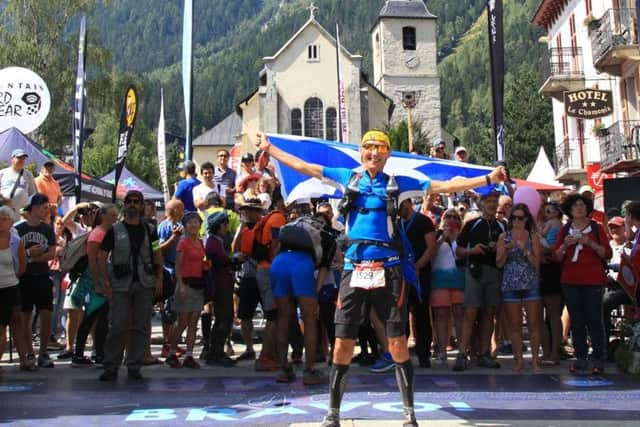'I was told to forget about running again'


Born in St Andrews, Bob has completed some of the most gruelling tests of physical endurance in the world, levels of exercise which would turn most white in fear.
His desire and personal motivation to complete challenges like the Etape du Tour race, completed over the Tour de France mountain stages (100 miles Alps and 125 miles Pyrenees) is inspirational -–even more so when you learn of his back story.
Advertisement
Hide AdAdvertisement
Hide AdFor the only list which can challenge the events Bob has ticked off, is the list of physical ailments and injuries he’s had to compete with and battle back from.


And these are no sprained ankles or shin splints, the athlete having to endure years of rehabilitation after a motorbike accident, and having to balance his physical activity with an on-going heart problem.
But he simply refuses to let anything thrown at him hold him back.
In the early 90s Bob started to take his health more seriously and got into exercise after stopping smoking.
He started walking, then hill walking and then running.
Advertisement
Hide AdAdvertisement
Hide Ad

Munros were bagged, local charity 10ks and half marathons completed, and then even his first London Marathon in 1996.
But then Bob’s world was turned upside down.
“Just as I was really hitting my stride, so to speak, disaster struck,” he said.
“I was getting right into running but, in July 1997, my leg was very badly damaged in a motor cycle accident while returning from hill walking in Glencoe.
“My right tibial plateau sustained a grade six high energy fracture and was shattered into seven pieces.
Advertisement
Hide AdAdvertisement
Hide Ad“I was told by a physiotherapist to forget about running again.”
After spending a month in hospital Bob was discharged with his leg held together with screws and a metal external fixation device.
His long road to recovery was just about to get started.
“After four weeks in hospital I’d gone from running marathons to being exhausted just getting washed and dressed,” he said.
“There were to be many dark days, but part one of a long rehabilitation process had begun.”
Advertisement
Hide AdAdvertisement
Hide AdThe following years would see Bob return to hospital for three further operations.
Before the second in December 1998 his leg had started to bend out at a 30 degree angle, making walking without sticks impossible.
“I was determined not to let the surgeon’s work go to waste so the gruelling, painful recuperation continued,” added Bob, now of Markinch.
“I was told at one point if I could stress my leg enough it would encourage bone growth.
Advertisement
Hide AdAdvertisement
Hide Ad“So I would be out walking up to 10 miles with a hinge at the knee plaster cast on my leg and carrying a rucksack full of extra weight.
“I also climbed my local hill, East Lomond, with a full plaster cast using crutches.”
Bob was breaking through the pain barrier to get things back on track.
It was tough, but, typically, he remained determined and resolute, beginning to work small jogs into his regular walks when he could.
Advertisement
Hide AdAdvertisement
Hide AdGradually it began to come back to him and he “shuffled” around the London Marathon in 1998 and 2000 and began to climb Munros again.
Confident that things were starting to look up, Bob returned to serious running, taking on road marathons, trail runs and hill races, as well as cycling long distances.
In 2003 Bob entered - and finished - the 2003 West Highland Way race in 22 hours 39 minutes.
His motorcycle accident, and the long recovery from it, was tough on him and his family - but finally he put it behind him and was back doing what he loved - testing his body to its limit on some of the most challenging terrains in the world.
Advertisement
Hide AdAdvertisement
Hide AdJust as things were looking up, sadly, again circumstances took a turn for a worse.
In 2002 he was diagnosed with a debilitating heart condition called atrial fibrillation which causes the normal controlling timer in the heart to be overridden.
In atrial fibrillation, the heart rate is irregular and can sometimes be very fast.
In some cases, it can be considerably higher than 100 beats a minute.
Advertisement
Hide AdAdvertisement
Hide AdIt causes heart palpitations and breathlessness and can lead to blood clotting or a stroke.
“Running, cycling and general exercising were triggering long and frequent episodes of atrial fibrillation and it made training very difficult and potentially dangerous,” said Bob.
“But I continued to try as best I could.
“I completed many running and cycling events over the following years while suffering from AF.
“I was getting slower and it certainly wasn’t getting any easier.”
Advertisement
Hide AdAdvertisement
Hide AdTypically Bob refused to throw in the towel and remained positive and active.
His attitude and outlook on life wasn’t to give up and neglect himself and his fitness, but to keep going.
He underwent a catheter ablation procedure to treat the structural problems in his heart in 2007 which managed to give him some respite until it started to flare up again in 2013.
But things began to get worse again and his condition progressed to the point that his heart was in a state of almost permanent AF.
Advertisement
Hide AdAdvertisement
Hide AdThis led to a second catheter ablation procedure on his heart in 2015.
“I had also now developed the condition atrial flutter,” added Bob.
“The suspected heart cells causing this problem were also ablated during the same operation.”
Incredibly Bob still didn’t slow down, and went on to complete arguably some of the toughest challenged he’d faced.
Advertisement
Hide AdAdvertisement
Hide AdHe completed some of the big European mountain ultra marathons including the 160km Grand Raid Pyrenees.
Conditions were tough, ranging from -10 to +33.
“I also climbed Mont Blanc without a guide in 2017,” he said.“This mountain is the highest in the Alps and at 4810 metres it was quite a challenge, especially for me.
“Over the last few years I have been experiencing a further reduction in heart function as my heart beat remains very low and is not responding to the increased demand when I try to exercise or just be active.
“It seems my heart’s sinoatrial node’s response is now blunted.
Advertisement
Hide AdAdvertisement
Hide Ad“The node is the natural pacemaker of the heart and controls the heart rate by generating electrical impulses and then sending electrical signals through the heart muscle, causing the heart to contract and pump blood throughout the body.
“This problem is making all exercise and activity increasingly difficult.
“Maybe an artificial pacemaker may help me at some point.
“I am determined to try to continue to exercise and participate in events for as long as I can.
“I regularly enjoy the group spin cycle and circuit classes at Michael Woods Sports Centre and days out on the Scottish hills.”
Advertisement
Hide AdAdvertisement
Hide AdOf all his achievements he says his proudest came after he ran the West Highland Way race in 2003, then going on to finish a further 11 of the races.
His best time was 20 hours 10 minutes.
Bob is currently training as best he can to finish his sixth Ultra Trail du Mont Blanc, fourth Transvulcania Ultramarathon and also a second Salomon Glencoe Skyline in 2018.
Few would bet against him breaking the tape in these events and adding to his already impressive list.
For whatever life seems to throw at Bob, there’s just no slowing him down.